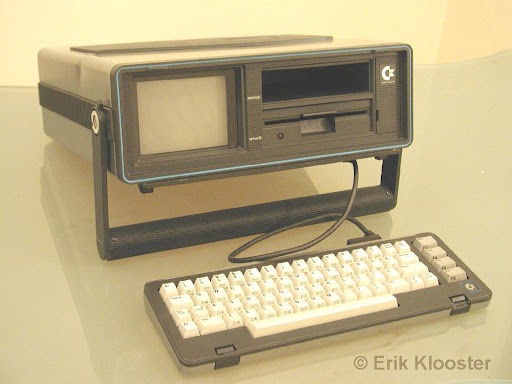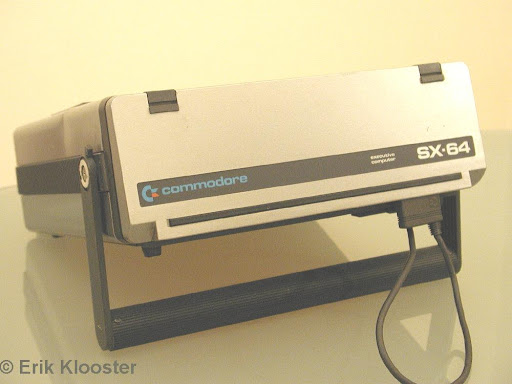





In addition, the cassette port and RF port were omitted from the SX-64 because it had a built-in disk drive and monitor, and thus no need for a tape drive or television connector. However, the omission made it impossible to use a standard C64 Centronics parallel printer interface without modification, since these interfaces used a connector on the cassette port to get +5V for operation. There were also subtle differences in the cartridge port, both electrically and in regards to its physical placement on the board, which made compatibility with certain C64 cartridges spotty.
Like the C64, the original SX-64's power supply limits the machine's expandability. Later units used a larger power supply intended for the DX-64.
Compatibility with Commodore RAM Expansion Units varies. Early SX-64 power supplies cannot handle the extra power consumption from the REU. The physical placement of the cartridge port can prevent the REU from seating properly. The 1700 and 1750, 128K and 512K units intended for the C128, are said to work more reliably with the SX-64 than the 1764 unit that was intended for the regular C64. Some SX-64 owners modified Commodore REUs to use an external power supply in order to get around the power supply issues.
An enhanced version of the SX-64 with dual floppy drives, known as the DX-64, was announced and a few have been reported to exist, but it is very rare. Some hobbyists installed a second floppy drive themselves in the SX-64's empty drive slot. A version with a monochrome screen called the SX-100 was announced but never released.
The SX-64 did not sell well, and its failure has been variously attributed to its small screen, high weight, bad marketing, and smaller business software library than that of its competitors, the Osborne 1 (Zilog Z80 CPU, CP/M OS) and Compaq Portable (16-bit CPU, MS-DOS). In addition, the Osborne and Compaq computers were faster, and in the case of the Osborne, was competitively priced.
The exact number of SX-64 sold from 1984 to 1986, when it was discontinued, is unknown. Due to the frequency of SX-64s sold today on online auction sites, it would be fair to say that thousands of these units were manufactured. The serial number database at SX64 Dot Net has records of over 130 SX-64s from series GA1, GA2, GA4, GA5 and GA6, with serial numbers ranging over 49,000 for series GA1, 1,000 for GA2, 17,000 for GA4, 11,000 for GA5, and 7,000 for GA6.
Some would-be buyers waited instead for the announced DX-64, which never became widely available due to the slow sales of the SX-64, creating a Catch-22 situation. The SX-64 did however gain a following with user groups and software developers, who could quickly pack and unpack the machine to use for copying software or giving demonstrations.
Technical information-
Like the Commodore 64, except the following:
Built-in storage: 170 kB 5¼" floppy disk drive (internal version of the Commodore 1541)
Built-in display: 5 inch (127 mm) composite color monitor
Keyboard: separate unit, connected by cord to CPU unit.
Cartridge port: placed on top of CPU unit, w/spring-loaded fold-in lid, cartridges inserted vertically (vs horizontally into back of C64)
I/O connectors:
no Datassette interface
no RF modulator & connector
non-standard 25-pin keyboard connector below right side of front panel. The connectors are similar but not identical to D-subminiature connectors and notoriously almost impossible to find today.
standard three-prong AC power connector (vs DIN plug from C64 "power brick" PSU)
Power supply: internal unit with transformer and rectifiers (vs external C64 PSU)
Extra features: floppy disk storage compartment above disk drive
| NAME | SX/DX 64 - Executive computer |
| MANUFACTURER | Commodore |
| TYPE | Transportable |
| ORIGIN | U.S.A. |
| YEAR | 1983 |
| BUILT IN LANGUAGE | SX-64 Basic v2.0 |
| KEYBOARD | Full-stroke detachable keyboard, 66 keys, 4 function keys |
| CPU | 6510 |
| SPEED | 1 Mhz |
| CO-PROCESSOR | VIC II (Video), SID (Sound) |
| RAM | 64k (38911 bytes free) |
| ROM | 20k |
| TEXT MODES | 40 chars. x 25 lines with 16 colors |
| GRAPHIC MODES | several, most used : 320 x 200 |
| COLORS | 16 |
| SOUND | 3 voices, 9 octaves, 4 waveforms |
| SIZE / WEIGHT | 36.8 (W) x 36.8 (D) x 12.7 (H) cm |
| I/O PORTS | 2 joystick sockets (Atari standard), cartridge slot, expansion port, serial, RGB video output, keyboard |
| BUILT IN MEDIA | SX-64 : 1 x 5''1/4 FDD |
| POWER SUPPLY | Built-in power supply unit |
| PERIPHERALS | Z80 card |
| PRICE | SX-64 : US$ 1000 (USA, may 1983) - £895 (U.K., 1984) |





0 comments:
Post a Comment